Kommander can also deploy services from a catalog of current cloud native services with the push of a button. This helps organizations quickly deploy services to multiple clusters. Governance-based access to data services ensures roles and responsibilities are maintained. Some of these services are Certified services, which means that you can subscribe to support for them from Kommander.

Kommander can be extended with the AddonRepository resource that point to git repositories containing application platform services. For example, the kubeaddons-enterprise repo contains platform services such as Jenkins and Kafka with specific settings for each service. Platform services can be composed using either Helm V2 charts or KUDO operators.
Example AddonRepository resource to add a new repository to your catalog:
apiVersion: kubeaddons.mesosphere.io/v1beta1
kind: AddonRepository
metadata:
name: kubeaddons-enterprise
namespace: project-namespace
spec:
priority: "20"
ref: “stable-1.26”
url: https://github.com/mesosphere/kubeaddons-enterprise
To deploy a platform service:
- Select Workspace > Project
- Select View Catalog to browse the available platform services from your configured repositories.
- Select your desired platform service.
- Select the version you’d like to deploy from the version drop-down, and then select Deploy.
For all platform services, you must provide a display name and an ID. The ID will be automatically generated based on what is entered for the display name, unless or until you edit the ID directly. The ID must be compliant with Kubernetes DNS subdomain name validation rules.
Optionally, you can customize the helm chart values or KUDO parameters of a service before deploying it.
For Helm-based platform services, specify the chart values in a YAML editor:

For KUDO-based platform services, fill out the form fields supported by that platform service’s parameters schema:

After a platform service is deployed in a project, the service is installed to all clusters in that project.
Since a project Platform Service is simply a Kubernetes FederatedAddon, it can also be created using kubectl:
cat << EOF | kubectl create -f -
apiVersion: types.kubefed.io/v1beta1
kind: FederatedAddon
metadata:
name: jenkins
namespace: ${projectns}
spec:
placement:
clusterSelector: {}
template:
apiVersion: kubeaddons.mesosphere.io/v1beta1
kind: Addon
metadata:
annotations:
appversion.kubeaddons.mesosphere.io/jenkins: 1.9.4
catalog.kubeaddons.mesosphere.io/addon-revision: 1.9.4-1
catalog.kubeaddons.mesosphere.io/origin-repository: https://github.com/mesosphere/kubeaddons-enterprise
catalog.kubeaddons.mesosphere.io/origin-repository-version: master
values.chart.helm.kubeaddons.mesosphere.io/jenkins: https://raw.githubusercontent.com/jenkinsci/helm-charts/main/charts/jenkins/values.yaml
labels:
kubeaddons.mesosphere.io/name: jenkins
name: jenkins
spec:
chartReference:
chart: stable/jenkins
values: |
---
master:
useSecurity: false
installPlugins:
- prometheus:2.0.6
- kubernetes:1.18.2
- workflow-job:2.33
- workflow-aggregator:2.6
- credentials-binding:1.19
- git:3.11.0
csrf:
defaultCrumbIssuer:
enabled: false
proxyCompatability: false
serviceType: "ClusterIP"
jenkinsUriPrefix: "/jenkins"
ingress:
enabled: true
path: /jenkins
annotations:
kubernetes.io/ingress.class: traefik
version: 1.9.4
EOF
Ensure the projectns variable is set before executing the command. This variable is the project namespace (i.e. Kubernetes Namespace associated with the project) that was defined/created when the project itself was initially created.
Then, if you run the following command on a Kubernetes cluster associated with the Project, you’ll see a Kubernetes Addon Object, in the corresponding namespace:
$ kubectl -n ${projectns} get addons.kubeaddons.mesosphere.io jenkins -o yaml
apiVersion: kubeaddons.mesosphere.io/v1beta1
kind: Addon
metadata:
creationTimestamp: "2020-06-05T12:06:10Z"
finalizers:
- finalizer.kubeaddons.mesosphere.io
generation: 1
labels:
kubeaddons.mesosphere.io/name: jenkins
kubefed.io/managed: "true"
name: jenkins
namespace: project2-cmzh9-xwc2g
resourceVersion: "18078"
selfLink: /apis/kubeaddons.mesosphere.io/v1beta1/namespaces/project2-cmzh9-xwc2g/addons/jenkins
uid: 60c869ad-b9b9-43fb-a78b-fcab2809e5bb
spec:
chartReference:
chart: stable/jenkins
values: |
---
master:
useSecurity: false
installPlugins:
- prometheus:2.0.6
- kubernetes:1.18.2
- workflow-job:2.33
- workflow-aggregator:2.6
- credentials-binding:1.19
- git:3.11.0
csrf:
defaultCrumbIssuer:
enabled: false
proxyCompatability: false
serviceType: "ClusterIP"
jenkinsUriPrefix: "/jenkins"
ingress:
enabled: true
path: /jenkins
annotations:
kubernetes.io/ingress.class: traefik
version: 1.9.4
cloudProvider:
- enabled: true
name: aws
- enabled: true
name: azure
- enabled: true
name: docker
- enabled: true
name: none
kubernetes:
minSupportedVersion: v1.16.3
status:
ready: false
stage: deploying
The Konvoy Addon Controller is then responsible for deploying the application.
After the platform service is deployed, the platform service may be upgraded to a newer version. The only versions shown are compatible with the clusters in that project.

Project Platform Services Catalog
Project Platform Services Catalog…Read More
Creating Federated Platform Services
Creating Federated Platform Services…Read More
Helm Based Platform Services
Project Platform Services based on Helm Charts.…Read More
KUDO Based Platform Services
Project Platform Services based on KUDO.…Read More
 Kommander Documentation
Kommander Documentation